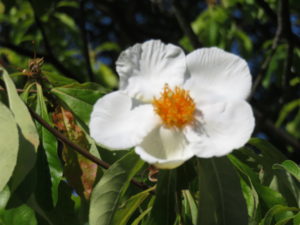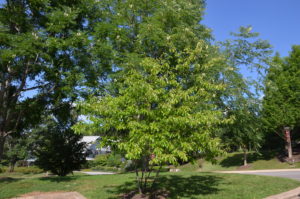Franklinia (Franklinia altamaha) is a uniquely different large shrub or small tree. Great plant for the “I can grow anything crowd”. Rated hardy in USDA hardiness zones 5-8, I’ve never seen a landscape quality specimen in zone 5 and find that the tree performs best in zones 6 to 7. Success with growing franklinia hinges on purchasing a quality nursery plant, proper siting, and annual care, particularly in the first 2-3 years. Franklinia is only available from e-commerce nurseries and is best planted in late winter and early spring.
The species was first discovered growing in 1765 growing along the banks of the Altamaha River in southeastern Georgia by botanists John and William Bartram. The tree has been extinct in the wild since 1803. All franklinia trees are descendants from seedling propagated by the Bartrams in their Philadelphia, PA garden. Franklinia belongs to the tea family (Theaceae) and is closely related to Camellia, Stewartia and Gordonia (loblolly bay). The tree was named to honor Benjamin Franklin.
The tree’s most striking feature is the showy 2 – 3 inch pure white flowers with clusters of golden yellow stamens in the centers. The camellia-like flowers appear in late summer until frost. The blooms are sweetly-fragrant upclose. Narrow, oblong-obovate, glossy dark green 3-5 inch long leaves turn multi-shades of orange, red and purple thru the autumn season. Branching is upright and spreading to create an open airy. Ridged grey bark with prominent vertical white striations adds some winter interest.
Franklinia grows best grown in organically rich, medium moist, well-drained soils in full sun (in North) to partial shade (in Southeast). Franklinia has a fibrous root system, preferring soil environs similar to azaleas and rhododendrons. To repeat, soil should be humus-rich, excellently drained, and moderately acidic (pH 5.0 – 6.2).
Fertilize in early spring with an acidic based soluble fertilizer such as Miracle Gro®, Miracid®, or Hollytone®. Franklinia also favors an annual feeding of Epsom salts (magnesium sulfate) @ 1 Tablespoon per gallon of water per tree.
Franklinia is valued as a specimen or a plant collector’s tree. This hard to grow tree deserves a prominent location in your landscape. Plant tree in late winter and early spring. Hard to transplant because of its sparsely fibrous root system.
Wilt and soil root rot (Phythoptera) are the serious problems. Franklinia has a reputation for being difficult to grow. Proper siting of the tree is absolutely essential to avoid tree loss.



 Posted in
Posted in 
